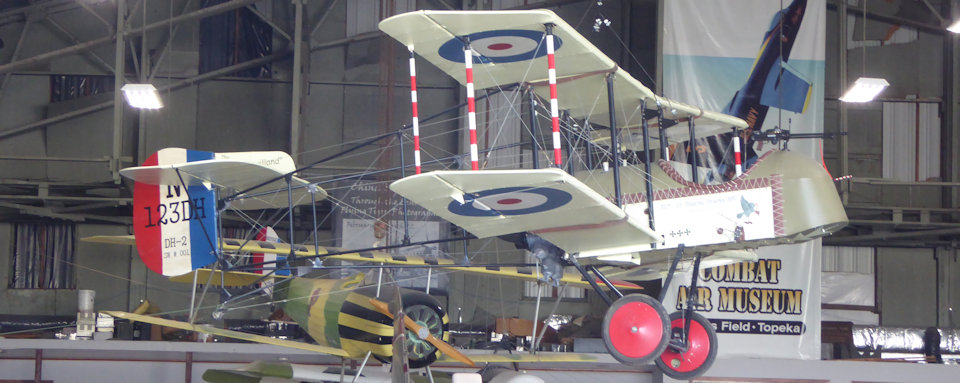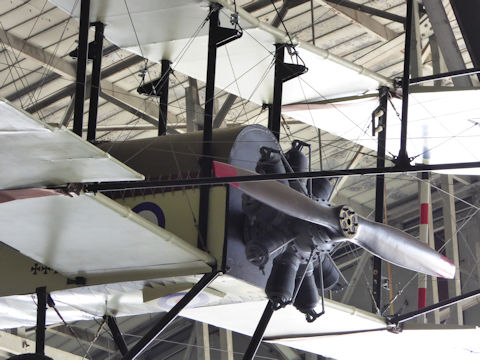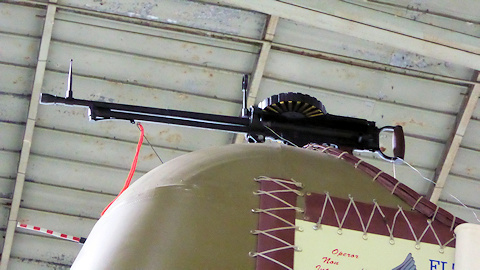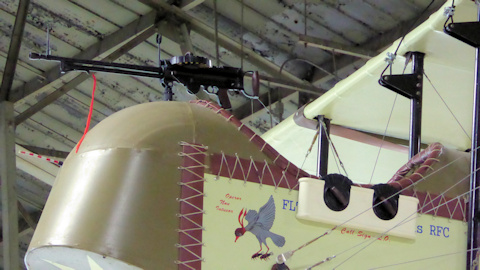


Developed in 1915, the DH-2 biplane was one of the first effective British fighters of World War One. Designed by Geoffrey de Havilland, the DH-2 was a response to the arrival of the Fokker Eindecker appearing over the Western Front. One of the first true fighters, the Eindecker began the "Fokker Scourge" which saw the Germans gain a decisive aerial advantage over the aging British and French aircraft.
A pusher biplane, the DH-2 featured a forward-firing .30 caliber Lewis machine gun mounted in the cockpit. Together with the Nieuport 11, the DH-2 was decisive in regaining Allied air superiority in the early months of 1916. In the stunning rate of generational aircraft development that marked the First World War, the DH-2 was eclipsed later that year by the next generation of German aircraft and was gradually withdrawn from frontline service.
The DH-2 was the second design by Geoffrey de Havilland for the Aircraft Manufacturing Company of Great Britain and 400 of his model design were built. In it's short life span the DH-2 was the best pusher scout of the war and one of the best fighting aircraft. This highly successful pusher had good maneuverability with an excellent rate of climb. Mounting the engine to the rear of the fuselage permitted the use of a fixed, forward-firing machine gun. The DH-2 was designed before the Fokker, with its synchronized gun, became a menace and thus, for a short period, the DH-2 proved superior to the older model Fokker Eindecker of early 1916.
Major Lanoe George Hawker (V.C. DSO) commanded the first DH-2 squadron (24 RFC) which landed in France on February 7th 1916. It was the first squadron composed of all single-seat fighters. Hawker became the first widely known British ace with seven credited victories. The DH-2 used the 100 HP Gnome rotary engine, climbed to 6,500 feet in 12 minutes and did 86 mph at that level. Its ceiling was 14,000 feet, but few pilots flew that high as it took over an hour to get to that level.
Major Hawker was flying his DH-2 (Serial No. 5964) at 10,000 feet on November 23, 1916, with two members of his squadron, when he saw three Albatross D.IIs below. The German D.II, a product of late 1916 with synchronized Spandau machine guns, was in every way superior to the British DH-2. The DH-2 pilots, however, did not hesitate to attack with altitude in their favor. Hawker's opponent was the 'Red Baron', Manfred Von Richthofen. The resulting duel was probably one of the most spectatcular man-to-man aerial battles in history.
Hawker and Richthofen became separated from the rest and fought for nearly 45 minutes. They began circling each other at 9,000 feet and fought down to the tree tops. Richthofen apparently fired about 900 rounds during the running battle. The wind, blowing toward the German lines, tipped the scales against Hawker as the two ships gradually lost altitude. Almost down to ground level and running short on fuel, Hawker had only two choices; land in German territory or risk being killed in an attempt to break off combat and head for Allied lines.
Von Richthofen's guns jammed 50 yards from the lines, but a bullet from his last burst struck Hawker in the back of his head, killing him instantly. German soldiers reported burying Major Hawker 250 yards (230 metres) east of Luisenhof Farm, just south of Bapaume on the Flers Road, along the roadside. Richthofen claimed Hawker's Lewis gun from the wreck as a trophy and hung it above the door of his quarters. Major Lanoe George Hawker is listed on the Arras Flying Services Memorial for airmen lost with no known grave.
There were over 200 DH-2s in France during mid-1916, a big factor in the early British air dominance during the Somme Offensive.
The DH-2 was gradually replaced by the French Nieuports during 1917. Well past its prime and almost two years after its introduction, some squadrons of the Royal Flying Corps were stiil equipped with DH-2s in 1918.
This 80% scale DH-2 replica was built by Dick and Sharon Starks and donated by them to the Combat Air Museum in October 2015.
In November 2015 Professor Huw Thomas constructed a CAD drawing of the Gnome Monosoupape engine and printed an 80% scale replica engine, in parts, on a 3D Lulzbot TAZ 5 printer. On April 27, 2016 that printed engine was completely assembled, bonded and affixed to the DH-2 aircraft at the Museum.In 2017 Professor Thomas completed an 80% scale replica Lewis Machine Gun and aircraft side-mounted spare Magazine Pouch using the same CAD and 3D printing technology. Exactly one year after the 3D printed Gnome engine was affixed and the plane hung from the rafters, at the Museum, the Lewis gun and side pouch were affixed to the DH-2, in situ.
Link to:
The development of the printed engine
and
Animation of the Gnome engine showing the parts as printed


Below: On Thursday April 27, 2017 a 3D printed Lewis Machine Gun and Magazine Side Pouch was added to the exhibit


TECHNICAL
NOTES: |
ORIGINAL FULL SCALE MODEL |
Manufacturer: |
Aircraft Manufacturing Company, Ltd. (Airco), Great Britain |
Primary
Use: |
Air assault/utility/general purpose/gun ship |
Crew: |
One |
Power Plant: |
One Gnome Monosoupape, 9 cylinder, air cooled rotary, 100 hp |
Max speed: |
93 mph (150 km/h) |
| Endurance: | 2 hrs 45 mins |
Service ceiling: |
14,000 ft (4,267 m) |
| Wingspan: | 28 ft 3 in (8.61 m) |
Length: |
25 ft 2 1/2 in (7.68 m) |
Height: |
9 ft 6 1/2 in (2.91 m) |
Weight: Empty: |
1,356 lbs (615kg) |
Gross Weight |
1,441 lbs (653.6 kg) |
Armaments: |
1 forward mounted .30 cal Lewis machine gun |